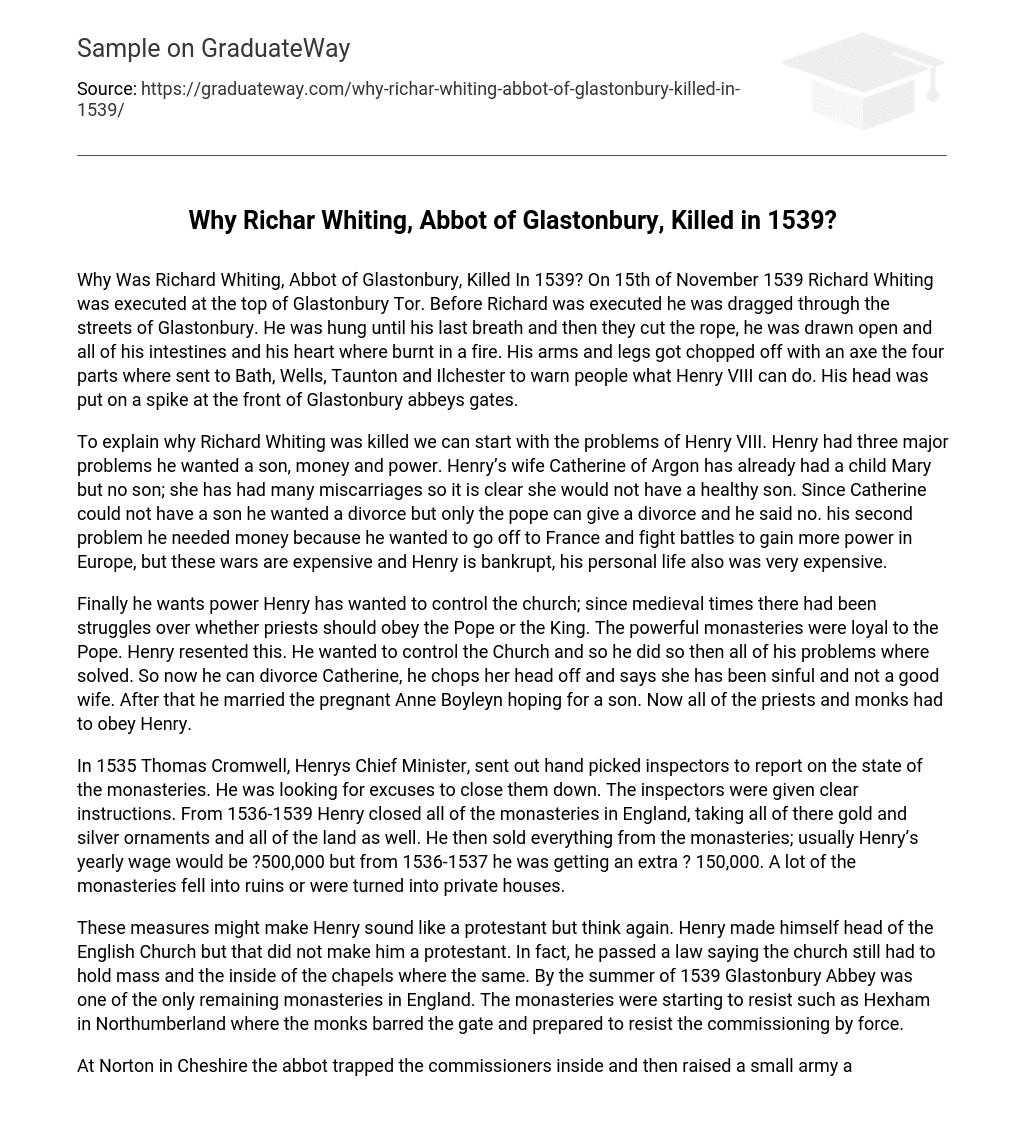Why Was Richard Whiting, Abbot of Glastonbury, Killed In 1539? On 15th of November 1539 Richard Whiting was executed at the top of Glastonbury Tor. Before Richard was executed he was dragged through the streets of Glastonbury. He was hung until his last breath and then they cut the rope, he was drawn open and all of his intestines and his heart where burnt in a fire. His arms and legs got chopped off with an axe the four parts where sent to Bath, Wells, Taunton and Ilchester to warn people what Henry VIII can do. His head was put on a spike at the front of Glastonbury abbeys gates.
To explain why Richard Whiting was killed we can start with the problems of Henry VIII. Henry had three major problems he wanted a son, money and power. Henry’s wife Catherine of Argon has already had a child Mary but no son; she has had many miscarriages so it is clear she would not have a healthy son. Since Catherine could not have a son he wanted a divorce but only the pope can give a divorce and he said no. his second problem he needed money because he wanted to go off to France and fight battles to gain more power in Europe, but these wars are expensive and Henry is bankrupt, his personal life also was very expensive.
Finally he wants power Henry has wanted to control the church; since medieval times there had been struggles over whether priests should obey the Pope or the King. The powerful monasteries were loyal to the Pope. Henry resented this. He wanted to control the Church and so he did so then all of his problems where solved. So now he can divorce Catherine, he chops her head off and says she has been sinful and not a good wife. After that he married the pregnant Anne Boyleyn hoping for a son. Now all of the priests and monks had to obey Henry.
In 1535 Thomas Cromwell, Henrys Chief Minister, sent out hand picked inspectors to report on the state of the monasteries. He was looking for excuses to close them down. The inspectors were given clear instructions. From 1536-1539 Henry closed all of the monasteries in England, taking all of there gold and silver ornaments and all of the land as well. He then sold everything from the monasteries; usually Henry’s yearly wage would be ?500,000 but from 1536-1537 he was getting an extra ? 150,000. A lot of the monasteries fell into ruins or were turned into private houses.
These measures might make Henry sound like a protestant but think again. Henry made himself head of the English Church but that did not make him a protestant. In fact, he passed a law saying the church still had to hold mass and the inside of the chapels where the same. By the summer of 1539 Glastonbury Abbey was one of the only remaining monasteries in England. The monasteries were starting to resist such as Hexham in Northumberland where the monks barred the gate and prepared to resist the commissioning by force.
At Norton in Cheshire the abbot trapped the commissioners inside and then raised a small army and laid siege to his own monastery! Richard Whiting did eventually sign the letter along with twenty one other Abbots but Rome still refused to grant the King a divorce. Henry convicted Richard of treason for remaining loyal to Rome in 1539. Before Richard was executed he was dragged through the streets of Glastonbury. He was hung drawn and quartered, His arms and legs got chopped off with an axe the four parts where sent to Bath, Wells, Taunton and Ilchester to warn people what Henry VIII can do.
His head was put on a spike at the front of Glastonbury abbeys gates. In 1517, Martin Luther posted a 95-page thesis on the door of the Church of Wittenberg. Once this thesis was attached to the door, the ideas contained within it began to spread to the many different parts of Europe. People everywhere used Luther’s ideas to help form their own ideas about God and to start their own church denominations. Protestantism sprang up from this movement and the prominent idea behind this branch of Christianity was justification by faith: that God saved people by faith in Jesus Christ alone.





